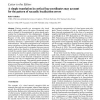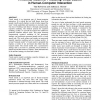62 search results - page 6 / 13 » Predicting postcompletion errors using eye movements |
BC
2004
13 years 7 months ago
2004
During saccadic eye movements, the visual world shifts rapidly across the retina. Perceptual continuity is thought to be maintained by active neural mechanisms that compensate for ...
ICPR
2004
IEEE
14 years 8 months ago
2004
IEEE
We propose an eye detection and tracking method based on color and geometrical features of the human face using a monocular camera. In this method a decision is made on whether th...
CHI
2007
ACM
14 years 7 months ago
2007
ACM
Visual search is an important part of human-computer interaction. It is critical that we build theory about how people visually search displays in order to better support the user...
ETRA
2000
ACM
13 years 11 months ago
2000
ACM
This paper describes EyeTracer, an interactive environment for manipulating, viewing, and analyzing eye-movement protocols. EyeTracer augments the typical functionality of such sy...
BC
2006
13 years 7 months ago
2006
Abstract In primates, it is well known that there is a consistent relationship between the duration, peak velocity and amplitude of saccadic eye movements, known as the `main seque...


